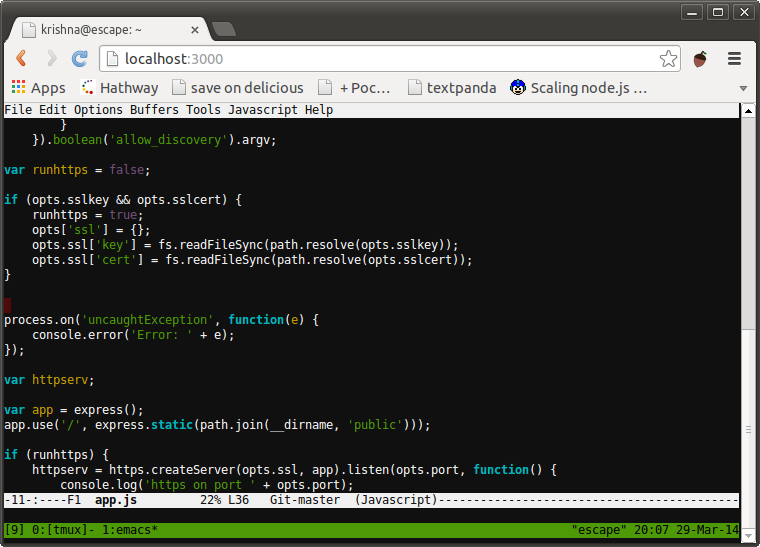|
|
7 years ago | |
|---|---|---|
| bin | 8 years ago | |
| public | 7 years ago | |
| src | 7 years ago | |
| .babelrc | 8 years ago | |
| .dockerignore | 8 years ago | |
| .eslintignore | 8 years ago | |
| .eslintrc.js | 8 years ago | |
| .gitignore | 7 years ago | |
| Dockerfile | 7 years ago | |
| LICENSE | 8 years ago | |
| README.md | 8 years ago | |
| app.js | 7 years ago | |
| cli.js | 7 years ago | |
| docker-compose.yml | 8 years ago | |
| gulpfile.js | 7 years ago | |
| index.js | 7 years ago | |
| package.json | 7 years ago | |
| terminal.png | 11 years ago | |
| wetty.js | 7 years ago | |
| yarn.lock | 7 years ago | |
README.md
Wetty = Web + tty
Terminal over HTTP and HTTPS. Wetty is an alternative to ajaxterm/anyterm but much better than them because wetty uses ChromeOS' terminal emulator (hterm) which is a full fledged implementation of terminal emulation written entirely in Javascript. Also it uses websockets instead of Ajax and hence better response time.
This fork has a few of the open PR's from the original merged in as well as scripts to make running in docker better.
Install
git clone https://github.com/butlerx/wettycd wettyyarn
or
yarn add wetty.js
Run on HTTP
node app.js -p 3000
If you run it as root it will launch /bin/login (where you can specify
the user name), else it will launch ssh and connect by default to
localhost.
If instead you wish to connect to a remote host you can specify the
--sshhost option, the SSH port using the --sshport option and the
SSH user using the --sshuser option.
You can also specify the SSH user name in the address bar like this:
http://yourserver:3000/wetty/ssh/<username>
or
http://yourserver:3000/ssh/<username>
Run on HTTPS
Always use HTTPS. If you don't have SSL certificates from a CA you can create a self signed certificate using this command:
openssl req -x509 -newkey rsa:2048 -keyout key.pem -out cert.pem -days 30000 -nodes
And then run:
node app.js --sslkey key.pem --sslcert cert.pem -p 3000
Again, if you run it as root it will launch /bin/login, else it will
launch SSH to localhost or a specified host as explained above.
Run wetty behind nginx
Put the following configuration in nginx's conf:
location /wetty {
proxy_pass http://127.0.0.1:3000/wetty;
proxy_http_version 1.1;
proxy_set_header Upgrade $http_upgrade;
proxy_set_header Connection "upgrade";
proxy_read_timeout 43200000;
proxy_set_header X-Real-IP $remote_addr;
proxy_set_header X-Forwarded-For $proxy_add_x_forwarded_for;
proxy_set_header Host $http_host;
proxy_set_header X-NginX-Proxy true;
}
If you are running app.js as root and have an Nginx proxy you have to use:
http://yourserver.com/wetty
Else if you are running app.js as a regular user you can use:
http://yourserver.com/wetty/ssh/<username>
or
http://yourserver.com/wetty
Note that if your Nginx is configured for HTTPS you should run wetty without SSL.
Dockerized Version
This repo includes a Dockerfile you can use to run a Dockerized version of wetty. You can run whatever you want!
Just modify docker-compose and run:
docker-compose up -d
Visit the appropriate URL in your browser ([localhost|$(boot2docker ip)]:PORT).
The default username is term and the password is term, if you did not modify SSHHOST
If you dont want to build the image yourself just remove the line build; .
Run wetty as a service daemon
Install wetty globally with global option:
init.d
$ sudo yarn global add wetty.js
$ sudo cp /usr/local/lib/node_modules/wetty.js/bin/wetty.conf /etc/init
$ sudo start wetty
systemd
$ yarn global add wetty.js
$ cp ~/.config/yarn/global/node_modules/wetty.js/bin/wetty.service ~/.config/systemd/user/
$ systemctl --user enable wetty
$ systemctl --user start wetty
This will start wetty on port 3000. If you want to change the port or redirect
stdout/stderr you should change the last line in wetty.conf file, something
like this:
exec sudo -u root wetty -p 80 >> /var/log/wetty.log 2>&1
FAQ
What browsers are supported?
Wetty supports all browsers that Google's hterm supports. Wetty has been reported to work on Google Chrome, Firefox and IE 11.
Why isn't Wetty working with IE?
This fix has been known to help some users.
